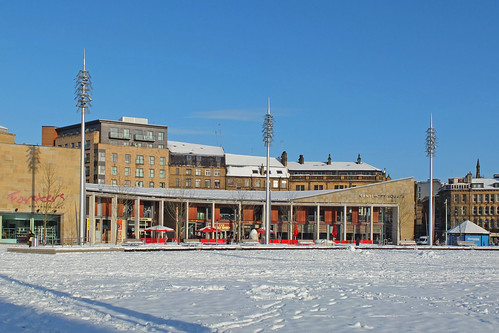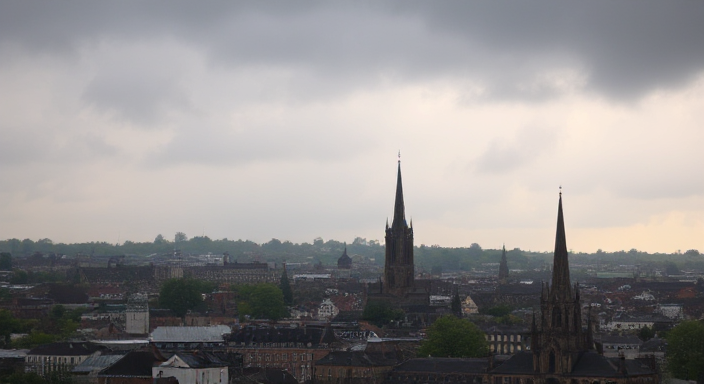Bradford Weather: A Comprehensive Guide to Yorkshire’s Climate

Bradford, a vibrant city nestled in the heart of West Yorkshire, England, boasts a rich history and a unique character. But its location also plays a significant role in shaping its weather patterns. Understanding Bradford’s weather is key to appreciating the city’s rhythm, planning activities, and even understanding the local culture. This article provides a comprehensive overview of Bradford’s weather, exploring its seasonal variations, microclimates, and the factors that contribute to its changeable nature.
Understanding Bradford’s Location: A Key to its Climate
Bradford’s location in West Yorkshire, in the foothills of the Pennines, significantly influences its weather. Its relatively high altitude and proximity to the hills contribute to its reputation for changeable conditions. The Pennines act as a barrier, influencing air flow and precipitation patterns. This geographical context is crucial for understanding why Bradford experiences the weather it does.
Seasonal Variations: Experiencing the Full Spectrum
Bradford experiences the four distinct seasons, each with its own unique characteristics.
Spring (March – May): Spring in Bradford is a season of transition, marked by gradual warming temperatures and increasing daylight hours. While early spring can still be chilly, with occasional frosts, temperatures begin to rise as the season progresses. Rainfall is common, nourishing the blossoming flora. Spring can be a beautiful time to visit Bradford, as the city comes alive with vibrant colors.
Summer (June – August): Summer is typically the warmest season in Bradford, although temperatures rarely reach extreme highs. The city enjoys longer daylight hours, making it ideal for outdoor activities. Rainfall can be sporadic, with occasional thunderstorms. Summer is a popular time for festivals and events in Bradford, taking advantage of the warmer weather.
Autumn (September – November): Autumn in Bradford is a season of dramatic change, with temperatures gradually cooling and leaves turning golden brown. Rainfall increases as the season progresses, and the days become shorter. Autumn can be a picturesque time to explore the surrounding countryside, with its stunning autumnal foliage.
Winter (December – February): Winter in Bradford is characterized by cold temperatures, often dipping below freezing. Snowfall is common, although heavy snow is less frequent than in some other parts of the UK. Winter can be a challenging time, with icy conditions and shorter daylight hours, but it also offers opportunities for cozy indoor activities and winter sports.
Rainfall Patterns: Embracing the Showers
Bradford is known for its relatively high rainfall, a characteristic shared with many parts of West Yorkshire. The city’s proximity to the Pennines contributes to this, as the hills force air upwards, causing it to cool and condense, leading to precipitation. Rainfall is fairly evenly distributed throughout the year, although it tends to be heavier in autumn and winter. Embracing the rain is part of the Bradford experience, and locals are well-prepared for wet weather.
Wind: The Breath of the Pennines
Bradford’s location also makes it susceptible to wind, particularly during the autumn and winter months. The wind can be strong at times, adding to the feeling of exposure and contributing to the changeable nature of the weather. Being prepared for windy conditions is essential, especially when venturing out into the surrounding hills.

Microclimates: Variations Within the City
Even within Bradford itself, there can be variations in weather conditions due to microclimates. Areas at higher elevations may experience colder temperatures and more snowfall than those in lower areas. Urban areas can also create their own microclimates, with slightly warmer temperatures due to the urban heat island effect. Understanding these local variations can be helpful for residents and visitors alike.
The Impact of Weather on Local Life: Shaping the Culture
Bradford’s weather has played a role in shaping the city’s culture and traditions. The need to adapt to changeable conditions has fostered a sense of resilience and resourcefulness among the local population. The weather also influences local activities, from outdoor pursuits in the summer to cozy gatherings in the winter. Understanding the weather is an integral part of understanding Bradford.
Adapting to Bradford’s Weather: Practical Tips
Being prepared for Bradford’s weather is essential for both residents and visitors. Here are a few practical tips:
Dress in Layers: Layering clothing is crucial, as temperatures can change quickly. Being able to add or remove layers allows you to adapt to changing conditions.
Carry an Umbrella and Rain Gear: Rain is a frequent occurrence in Bradford, so it’s always wise to carry an umbrella and waterproof clothing.
Check the Forecast: Staying up to date on the latest weather forecast is essential for planning activities and being prepared for any changes.
Be Prepared for Wind: Wind can be strong at times, so it’s important to be aware of your surroundings and take precautions, especially when walking in exposed areas.
Embrace the Weather: Rather than letting the weather dictate your plans, learn to embrace it. Bradford’s weather is part of its charm, and it can add to the experience of exploring the city and its surroundings.
The Future of Bradford’s Weather: Climate Change Considerations
Like many other parts of the world, Bradford is likely to experience the effects of climate change in the future. This could lead to changes in temperature patterns, rainfall patterns, and the frequency of extreme weather events. Understanding these potential changes is crucial for planning for the future and mitigating the impacts of climate change.
Bradford Weather: A Constant Conversation
Bradford’s weather is a frequent topic of conversation among locals. It’s a shared experience that connects people and shapes their daily lives. Whether it’s discussing the latest snowfall, commenting on the unexpected sunshine, or simply complaining about the rain, the weather is a constant presence in the minds of Bradford residents. It’s a part of what makes Bradford unique.
Exploring Bradford, Whatever the Weather
Despite its reputation for changeable weather, Bradford offers plenty to explore and enjoy, whatever the season. From its rich industrial heritage to its vibrant cultural scene, there’s something for everyone in this dynamic city. By being prepared for the weather and embracing its unpredictable nature, visitors and residents alike can fully appreciate all that Bradford has to offer. The weather is just one aspect of Bradford’s character, but it’s an important one that contributes to its unique charm.
FAQs
What is the general climate of Bradford?
Bradford has a temperate maritime climate, typical of much of the United Kingdom. It experiences relatively mild winters, cool summers, and moderate rainfall throughout the year. Due to its location in the Pennine Hills, Bradford can sometimes experience more rainfall than other areas in the region. The climate is characterized by significant weather changes and occasional periods of extreme temperatures.
What are Bradford’s temperatures like throughout the year?
In Bradford, temperatures vary depending on the season. Winters are relatively cold, with average highs of around 5-7°C in December and January, and lows that can dip below freezing on occasion. Summers are cooler than in southern parts of the UK, with average highs of around 15-18°C, although heatwaves can occasionally push temperatures higher. Spring and autumn are mild, with temperatures ranging from 8-15°C, depending on the month.
Does Bradford experience much rainfall?
Yes, Bradford experiences a significant amount of rainfall throughout the year. The city averages around 1,000 mm of rainfall annually, which is fairly typical for cities in the north of England. The wetter months are generally from October to January, with frequent, though not necessarily heavy, showers. Summer can also see periods of rain, but these are usually shorter and less frequent than in the autumn and winter months.
To read more, Click here


Leave a Comment